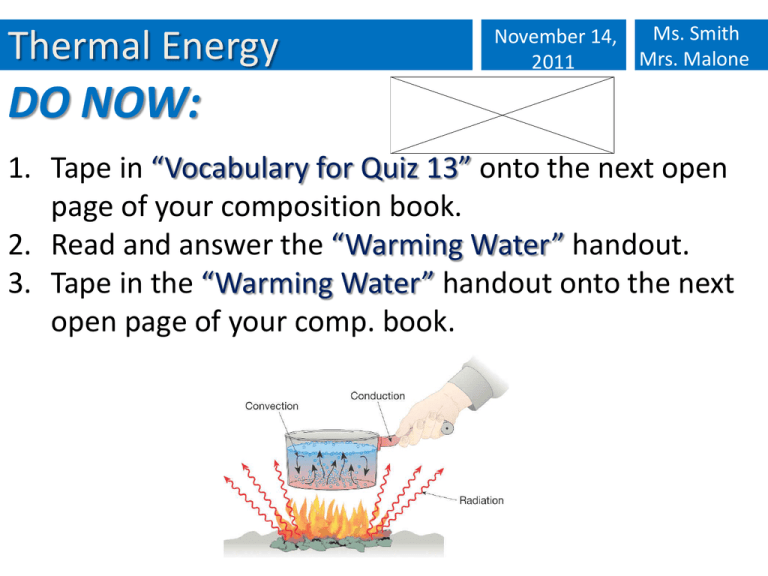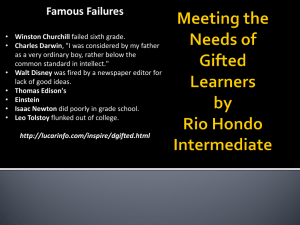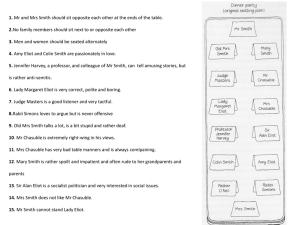radiation
advertisement

Thermal Energy November 14, 2011 Ms. Smith Mrs. Malone DO NOW: 1. Tape in “Vocabulary for Quiz 13” onto the next open page of your composition book. 2. Read and answer the “Warming Water” handout. 3. Tape in the “Warming Water” handout onto the next open page of your comp. book. Thermal Energy November 14, 2011 Effect of Heat on Atoms : Ms. Smith Mrs. Malone November 14, 2011 Thermal Energy Reminders Tutorials: Tuesday after school Vocabulary Quiz on Friday : Ms. Smith Mrs. Malone Thermal Energy November 14, 2011 Ms. Smith Mrs. Malone 1. Log onto your computer Username: S(Student Id #) Password: First letter of your last name Birthdate s 2. www.ohenryscience6.weebly.com 3. Click on the handouts tab 4. Open Week 13 PPT 5. Use the PPT to fill out the vocabulary foldable : Thermal Energy November 14, 2011 Ms. Smith Mrs. Malone Heat moves from warmer matter to cooler matter. warmer cooler Heat moves in 3 different ways: 1. Conduction 2. Convection : 3. Radiation Thermal Energy November 14, 2011 Ms. Smith Mrs. Malone Conduction The transfer of heat through a material by direct contact. Examples: 1. A metal spoon gets hot quickly in hot cocoa. 2. An iron heats up the material it comes in contact with. : List one more example on your foldable. Thermal Energy November 14, 2011 Ms. Smith Mrs. Malone Convection The transfer of heat in a fluid (gas or liquid) as a result of the movement of the fluid itself. : Note that the warm material rises, cools at the surface and then sinks in a circular pattern. Thermal Energy November 14, 2011 Convection Examples: 1. Pot of boiling water 2. Ocean currents List one more example of your foldable. Animations of conduction and convection: : Teacher's Domain Animations Ms. Smith Mrs. Malone Thermal Energy November 14, 2011 Ms. Smith Mrs. Malone Radiation The transfer of heat via electromagnetic waves through space. Examples: 1. The heat from the sun melting ice cream. 2. The heat from a campfire. : List one more example on your foldable Thermal Energy November 14, 2011 Ms. Smith Mrs. Malone 1. Tape in the vocabulary foldable on the next open page of your comp. book. 2. Go to the following website: http://austinisd.stemscopes.com/login 3. Log in information: Username: science6 Password: science6 : 3. Play either game as a review of what you just learned. Name:_________________________________ Period:_________________ Exit Ticket A. B. A:___________________ B:___________________ C:___________________ C. What is the difference between hot and cold water in terms of K.E.? ___________________________________________________________ ___________________________________________________________ November 14, 2011 Thermal Energy Review Why do we get sunburn? Radiation : Ms. Smith Mrs. Malone November 14, 2011 Thermal Energy Ms. Smith Mrs. Malone Review How does heat move through a pot of boiling water and make all the water boil? Convection : November 14, 2011 Thermal Energy Ms. Smith Mrs. Malone Review The roof of your mouth gets burned with hot pizza? Conduction : Thermal Energy November 15, 2011 Ms. Smith Mrs. Malone DO NOW: On the next open page of your journal explain why a chocolate bar melts in your hand. Try to use at least one of your new vocabulary terms in your science journal in your explanation. Don't forget to use labels if you draw a diagram. November 15, 2011 Thermal Energy Reminders Tutorials: Tuesday after school Vocabulary Quiz on Friday : Ms. Smith Mrs. Malone Thermal Energy November 15, 2011 Ms. Smith Mrs. Malone Heat moves from warmer matter to cooler matter. warmer cooler : Thermal Energy Block Day Ms. Smith Mrs. Malone DO NOW: 1. 2. Pick up the handout and one pair of goggles. In your composition book list at least one example of conduction, convection, and radiation. Block Day Thermal Energy Review Why do we get sunburn? Radiation : Ms. Smith Mrs. Malone Block Day Thermal Energy Ms. Smith Mrs. Malone Review How does heat move through a pot of boiling water and make all the water boil? Convection : Block Day Thermal Energy Ms. Smith Mrs. Malone Review The roof of your mouth gets burned with hot pizza? Conduction : Thermal Energy November 15, 2011 Ms. Smith Mrs. Malone Breath on a Cold Day: As the organism exhales, water vapor in the breath comes in contact with colder air. This causes water vapor to condense into water droplets which we can see suspended in the air. The heat from the organism’s breath warms up the surrounding cooler air. The movement of matter facilitates the transference of heat, so transfer is by convection. Thermal Energy November 15, 2011 Ms. Smith Mrs. Malone Steaming Hot Coffee: The hot coffee is at a higher temperature than the surrounding air and mug. Heat is transferred from the coffee to the mug/cooler air above the coffee and we see the water droplets condense by convection. Thermal Energy November 15, 2011 Ms. Smith Mrs. Malone Hot Soup with Metal Spoon: The hot soup is at a higher temperature than the metal spoon. The metal spoon is hot from energy transferred through contact by conduction. Thermal Energy November 15, 2011 Ms. Smith Mrs. Malone Ice Cream Melting in the Sun: Higher heat from the sun is transferred to the lower heated ice cream causing the ice cream to melt. The heat source is not directly touching the object it is warming up. (radiation). Thermal Energy November 15, 2011 Ms. Smith Mrs. Malone Heat Lamp: The heat from the lamp warms the air molecules by radiation. : Thermal Energy November 15, 2011 Ms. Smith Mrs. Malone Hot Spring Geyser: Hot springs are geothermal heated groundwater. Cooler water seeps into the ground and comes in contact with hot rocks associated with magma chambers below the Earth’s surface (conduction). As water is heated to above boiling point, it remains in liquid form due to intense pressure, but is much less dense, bringing it to the surface. (convection) : Thermal Energy November 15, 2011 Ms. Smith Mrs. Malone Boiling Water: The pot becomes hot from touching the heat source (conduction), the water at the bottom of the pot gets warm first, and moves upward since it becomes less dense. This pushes the cooler water at the top down, creating a convection current. Thermal Energy November 15, 2011 Ms. Smith Mrs. Malone Woodstove: Heat is transferred in two ways. Firelight transfers heat by radiation, the woodstove becomes hot due to conduction from the fire toughing the metal. The air inside the stove gets hot, rising and falling in a convection current. If you place an object on top of the stove, you have another example of conduction. : Thermal Energy November 15, 2011 Ms. Smith Mrs. Malone Mirage: Heat from the sun warms the black asphalt (radiation). The air directly above the asphalt becomes hotter, drastically changing the density levels of air near the ground. A wavy and often duplicate image appears because light bends when it passes from one medium to another (in this case: warmer air to cooler air). : Thermal Energy November 15, 2011 Ms. Smith Mrs. Malone Cooking in the Oven: Heat is transferred in an oven primarily through convection and by radiation (from heat being emitted from the hot walls. Convection ovens are different from conventional ovens in that they forcefully circulate the air. Thermal Energy November 15, 2011 Ms. Smith Mrs. Malone Toasting Marshmallows: The marshmallows are toasted by radiation. Thermal Energy November 15, 2011 Ms. Smith Mrs. Malone Ironing: The metal iron uses conduction to warm objects it comes in contact with. Thermal Energy November 15, 2011 Ms. Smith Mrs. Malone Toaster: The toaster uses radiation from the coils to toast the bread. Thermal Energy November 15, 2011 Ms. Smith Mrs. Malone Baking Cookies: The cookie sheet uses conduction to transfer heat. Inside the oven, radiation also allows the cookies to cook. Thermal Energy November 15, 2011 Microwave Oven: The microwave uses radiation to cook food. Ms. Smith Mrs. Malone Thermal Energy November 18, 2011 DO NOW: 1. Complete the “CAQ Concept Attainment Do Now” 2. Set-up two privacy folders for today’s quiz. Ms. Smith Mrs. Malone








